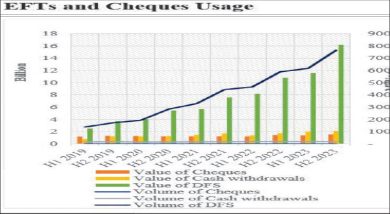Imports cost rise Hits transporters
Local importers will pay more to transport goods due to rising freight costs, translating to expensive imported goods and rising cost of living, a new survey shows.
The 2023 Cost, Insurance and Freight (CIF) Margin Survey jointly published last week by the National Statistical Office (NSO) and the Reserve Bank of Malawi (RBM) shows that the weighted CIF has increased to 15.1 percent for freight service payments and 0.8 percent for insurance service payments.
This means that the CIF margin
has increased from 13.1 percent recorded in 2000 to 15.9 percent at the end of 2022.
The survey further indicates that values for imports of goods have to be discounted by 15.9 percent to be reported on a free on board (FoB) basis.
A statement accompanying the survey jointly signed by NSO commissioner Lizzie Chikoti and RBM Governor Wilson Banda observes that the updated CIF margin will improve the estimation of cross-border freight and insurance service payments in the services account within the current account of Malawi’s balance of payments (BoP) statistics.

Reads the survey in part: “The updated ratio would further promote a correct classification of the adjustment in the services account of the BoP statistics in form of freight and insurance service payments for the imports.
“Ultimately, this would assist government in formulating informed macroeconomic and trade policy decisions.”
But in an interview yesterday, an industry insider observed that in the past three years, Malawi has experienced ‘catastrophic’ external shocks which led to increases in freight costs.
In addition to the recent 44 percent kwacha devaluation necessitated by the foreign exchange challenges, this could adversely affect importation costs.
Said the insider: “In the past three years, we have experienced catastrophic external shocks such as the Covid 19 pandemic during which the global supply chain was disrupted.
“There was an increase of freight costs as the world experienced shortages of containers. The effects of this disruption will continue to be felt.”
The industry insider said the
devaluation of the kwacha, fuel price hikes and general increase in the cost of doing business in Malawi adversely affect importation costs.
“Let me also state that this is not unique to Malawi, this is a general global issue,” he said.
The inspiration for conducting the 2023 CIF Margin Survey is drawn from the fact that CIF margins do change over time due to factors such as fuel prices, competition and technology in the transport industry, change in the proportion of different types of goods and changes in source economies.
From the 148 surveyed enterprises with import value ranging from K5 million to about K100 million, the survey also ascertained the contribution of sea, road and air transport to total freight charges paid when importing goods from the rest of the world with the road being the most dominant.
The results show that payments for freight services through road transport were the highest at K27.61 million between 2021 and 2022, representing 70.3 percent of all freight charges paid while sea transport at K9.9 million and air transport at K1.7 million, were less used.
In 1982, NSO analysed trade data for June 1980 and obtained a CIF margin of 27 percent while in 1985, the CIF margin of 40 percent was used in the BoP accounts.
However, there has been no documentation regarding how it was obtained.
In 1987, the ratio was determined to be 40 percent using both survey and administrative records and the ratio was found to be the highest in the world by a considerable margin.
International literature showed that no other country claimed to have a CIF margin of above 30 percent.
In 1999, the ratio stood at 15 percent and in 2000, it was computed as 13.1 percent, according to NSO.
The 2023 CIF Margin Survey was aimed at updating the ratio that is used for the adjustment of imports of goods, which are quoted on CIF basis to FoB valuation as recommended by the 6th Edition of the International Monetary Fund’s BoP and International Investment Position Manual.






One Comment